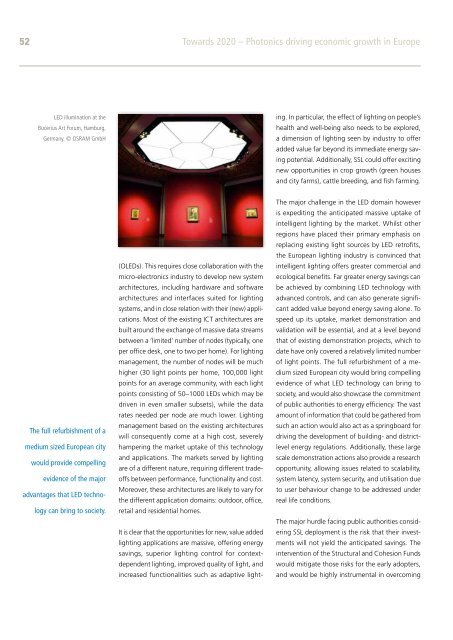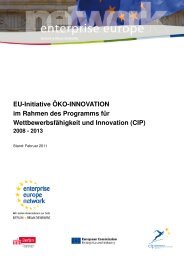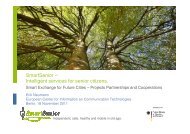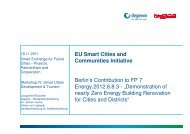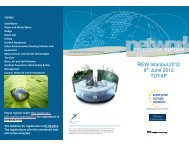Photonics Driving Economic Growth in Europe - Photonics21
Photonics Driving Economic Growth in Europe - Photonics21
Photonics Driving Economic Growth in Europe - Photonics21
Create successful ePaper yourself
Turn your PDF publications into a flip-book with our unique Google optimized e-Paper software.
52 Towards 2020 – <strong>Photonics</strong> driv<strong>in</strong>g economic growth <strong>in</strong> <strong>Europe</strong><br />
LED illum<strong>in</strong>ation at the<br />
Bucerius Art Forum, Hamburg,<br />
Germany. © OSRAM GmbH<br />
The full refurbishment of a<br />
medium sized <strong>Europe</strong>an city<br />
would provide compell<strong>in</strong>g<br />
evidence of the major<br />
advantages that LED techno-<br />
logy can br<strong>in</strong>g to society.<br />
(OLEDs). This requires close collaboration with the<br />
micro-electronics <strong>in</strong>dustry to develop new system<br />
architectures, <strong>in</strong>clud<strong>in</strong>g hardware and software<br />
architectures and <strong>in</strong>terfaces suited for light<strong>in</strong>g<br />
systems, and <strong>in</strong> close relation with their (new) appli-<br />
cations. Most of the exist<strong>in</strong>g ICT architectures are<br />
built around the exchange of massive data streams<br />
between a ‘limited’ number of nodes (typically, one<br />
per office desk, one to two per home). For light<strong>in</strong>g<br />
management, the number of nodes will be much<br />
higher (30 light po<strong>in</strong>ts per home, 100,000 light<br />
po<strong>in</strong>ts for an average community, with each light<br />
po<strong>in</strong>ts consist<strong>in</strong>g of 50–1000 LEDs which may be<br />
driven <strong>in</strong> even smaller subsets), while the data<br />
rates needed per node are much lower. Light<strong>in</strong>g<br />
management based on the exist<strong>in</strong>g architectures<br />
will consequently come at a high cost, severely<br />
hamper<strong>in</strong>g the market uptake of this technology<br />
and applications. The markets served by light<strong>in</strong>g<br />
are of a different nature, requir<strong>in</strong>g different tradeoffs<br />
between performance, functionality and cost.<br />
Moreover, these architectures are likely to vary for<br />
the different application doma<strong>in</strong>s: outdoor, office,<br />
retail and residential homes.<br />
It is clear that the opportunities for new, value added<br />
light<strong>in</strong>g applications are massive, offer<strong>in</strong>g energy<br />
sav<strong>in</strong>gs, superior light<strong>in</strong>g control for contextdependent<br />
light<strong>in</strong>g, improved quality of light, and<br />
<strong>in</strong>creased functionalities such as adaptive light-<br />
<strong>in</strong>g. In particular, the effect of light<strong>in</strong>g on people’s<br />
health and well-be<strong>in</strong>g also needs to be explored,<br />
a dimension of light<strong>in</strong>g seen by <strong>in</strong>dustry to offer<br />
added value far beyond its immediate energy sav<strong>in</strong>g<br />
potential. Additionally, SSL could offer excit<strong>in</strong>g<br />
new opportunities <strong>in</strong> crop growth (green houses<br />
and city farms), cattle breed<strong>in</strong>g, and fish farm<strong>in</strong>g.<br />
The major challenge <strong>in</strong> the LED doma<strong>in</strong> however<br />
is expedit<strong>in</strong>g the anticipated massive uptake of<br />
<strong>in</strong>telligent light<strong>in</strong>g by the market. Whilst other<br />
regions have placed their primary emphasis on<br />
replac<strong>in</strong>g exist<strong>in</strong>g light sources by LED retrofits,<br />
the <strong>Europe</strong>an light<strong>in</strong>g <strong>in</strong>dustry is conv<strong>in</strong>ced that<br />
<strong>in</strong>telligent light<strong>in</strong>g offers greater commercial and<br />
ecological benefits. Far greater energy sav<strong>in</strong>gs can<br />
be achieved by comb<strong>in</strong><strong>in</strong>g LED technology with<br />
advanced controls, and can also generate significant<br />
added value beyond energy sav<strong>in</strong>g alone. To<br />
speed up its uptake, market demonstration and<br />
validation will be essential, and at a level beyond<br />
that of exist<strong>in</strong>g demonstration projects, which to<br />
date have only covered a relatively limited number<br />
of light po<strong>in</strong>ts. The full refurbishment of a medium<br />
sized <strong>Europe</strong>an city would br<strong>in</strong>g compell<strong>in</strong>g<br />
evidence of what LED technology can br<strong>in</strong>g to<br />
society, and would also showcase the commitment<br />
of public authorities to energy efficiency. The vast<br />
amount of <strong>in</strong>formation that could be gathered from<br />
such an action would also act as a spr<strong>in</strong>gboard for<br />
driv<strong>in</strong>g the development of build<strong>in</strong>g- and districtlevel<br />
energy regulations. Additionally, these large<br />
scale demonstration actions also provide a research<br />
opportunity, allow<strong>in</strong>g issues related to scalability,<br />
system latency, system security, and utilisation due<br />
to user behaviour change to be addressed under<br />
real life conditions.<br />
The major hurdle fac<strong>in</strong>g public authorities consider<strong>in</strong>g<br />
SSL deployment is the risk that their <strong>in</strong>vestments<br />
will not yield the anticipated sav<strong>in</strong>gs. The<br />
<strong>in</strong>tervention of the Structural and Cohesion Funds<br />
would mitigate those risks for the early adopters,<br />
and would be highly <strong>in</strong>strumental <strong>in</strong> overcom<strong>in</strong>g


